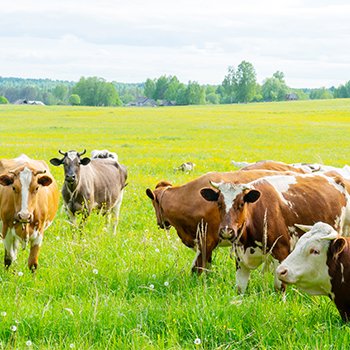สถานการณ์และทิศทางของอุตสาหกรรมโคเนื้อไทย
5019 Views |

By: ฝ่ายวิจัยและกลยุทธ์ สถาบันอาหาร
Department of Research and Strategy
National Food Institute
fic@nfi.or.th
โคเนื้อ นับว่าเป็นสัตว์เศรษฐกิจชนิดหนึ่งที่มีความสำคัญในการขับเคลื่อนระบบเศรษฐกิจของประเทศไทยให้เติบโต เนื่องจากอุตสาหกรรมโคเนื้อเป็นหนึ่งในอุตสาหกรรมการเกษตรขนาดใหญ่ที่สร้างรายได้ให้กับเกษตรกรและประเทศไทยอย่างมหาศาล
ภาพรวมการผลิตโคเนื้อของประเทศไทย
ในช่วงปี พ.ศ. 2561-2565 ที่ผ่านมา การผลิตโคเนื้อของไทยมีแนวโน้มลดลงร้อยละ 1.24 ต่อปี โดยเฉพาะในช่วงปี พ.ศ. 2563-2564 เนื่องจากการแพร่ระบาดของโรคอุบัติใหม่ คือ ลัมปี สกิน (Lumpy skin disease) ทำให้ผลผลิตบางส่วนได้รับความเสียหาย ขณะที่บางส่วนก็ไม่สามารถจำหน่ายและเคลื่อนย้ายเข้าสู่โรงฆ่าสัตว์ได้ ถึงแม้ว่าปัจจุบันจะมีการผลิตโคเนื้อในประเทศเพิ่มขึ้นแต่ก็ยังไม่เพียงพอต่อความต้องการของผู้บริโภค จึงต้องมีการนำเข้าโคเนื้อจากต่างประเทศ
อัตราการบริโภคเนื้อโคของไทย
ในปี พ.ศ. 2566 นี้ คาดว่าจะมีการบริโภคเพิ่มขึ้น เนื่องจากสถานการณ์การแพร่ระบาดของโรคโควิด-19 ได้คลี่คลายลง เมื่อพิจารณาปริมาณการบริโภคเนื้อสัตว์แต่ละชนิด พบว่า คนไทยมีรสนิยมการบริโภคเนื้อสัตว์ไม่แตกต่างจากผู้บริโภคทั่วโลก กล่าวคือ เนื้อไก่เป็นเนื้อสัตว์หลักที่คนไทยนิยมรับประทานมากที่สุด มีค่าเฉลี่ยการบริโภคคนละ 14.83 กิโลกรัมต่อปี ตามด้วยเนื้อหมู เนื้อโค เนื้อแกะ และเนื้อแพะ โดยคนไทยมีอัตราการบริโภคเนื้อโคเฉลี่ย 3 กิโลกรัมต่อคนต่อปี ทั้งนี้ การแปรรูปเนื้อโคเพื่อจำหน่ายในตลาดภายในประเทศยังไม่มีความหลากหลายมากนัก โดยทั่วไปจะเป็นการแปรรูปในลักษณะแช่เย็นและแช่แข็ง ขณะที่การแปรรูปอาหารในเชิงอุตสาหกรรม ส่วนใหญ่จะนำเนื้อโคไปแปรรูปเป็นผลิตภัณฑ์ลูกชิ้นและไส้กรอก
สถานการณ์การส่งออก-นำเข้าโคมีชีวิต เนื้อโคและผลิตภัณฑ์
การค้าเนื้อสัตว์ระหว่างประเทศมีอัตราการขยายตัวตามความต้องการที่เพิ่มขึ้นจากประเทศในทวีปเอเชียและประเทศใกล้เคียงในกลุ่มภูมิภาคอาเซียน แต่ในขณะเดียวกันการผลิตก็ยังไม่เพียงพอต่อความต้องการของผู้บริโภค และในปี พ.ศ. 2566 นี้ คาดว่าการส่งออกโคเนื้อโดยรวมจะลดลงอีก ซึ่งสอดคล้องกับข้อมูลปริมาณการนำเข้าโคเนื้อที่ขยายตัวอย่างมากทั้งในส่วนของการนำเข้าโคมีชีวิตและการนำเข้าเนื้อโคและผลิตภัณฑ์ โดยมีแหล่งนำเข้าเนื้อโคขุนคุณภาพดีจากประเทศออสเตรเลีย นิวซีแลนด์ อาร์เจนตินา รวมถึงโคพื้นเมืองจากประเทศเมียนมาร์และอินเดีย
โอกาสและทิศทางการเติบโตของอุตสาหกรรมโคเนื้อของไทย
การเติบโตของการบริโภคโปรตีนจากเนื้อสัตว์ทั่วโลกในทศวรรษหน้า คาดว่าจะมีการเพิ่มขึ้นร้อยละ 14 ภายในปี พ.ศ. 2573 เมื่อเทียบกับค่าเฉลี่ยของปี พ.ศ. 2561-2563 โดยมีแรงหนุนจากรายได้และการเติบโตของประชากรซึ่งเป็นปัจจัยหลักที่สนับสนุนแนวโน้มดังกล่าว ขณะเดียวกัน ความต้องการโปรตีนจากเนื้อโค เนื้อสุกร สัตว์ปีก และเนื้อแกะ คาดว่าจะมีอัตราการเติบโตร้อยละ 5.9
Beef cattle are one of the most important economic animals driving Thailand's economic growth. It is among one of the largest agricultural industries that generates tremendous income for both farmers and the country, consistent with beef consumption's increasing popularity.
An Overview of Beef Cattle Production in Thailand
During 2018-2022, beef cattle production in Thailand declined by 1.24% per year, especially during 2020-2021, due to the spread of a new emerging lumpy skin disease. This disease caused widespread damage to the produce, while a considerable part could not be sold and transported to the slaughterhouse. Although there is an increase in beef production, it may still not be sufficient to meet consumers' demand and has thus prompted imports from abroad.
Thai Beef Consumption Rate
The consumption trend is expected to increase in 2023 due to the easing of the COVID-19 pandemic. When considering meat consumption, it was found that Thais' meat consumption preferences are similar to those of consumers worldwide. Chicken is the most popular, with an average annual consumption rate of 14.83 kilograms per person, followed by pork, beef, lamb, and goat meat. The average beef consumption is currently at 3 kilograms per person per year. However, there is little variety in beef processing for sale in the domestic market. Generally, most of the beef on offer is chilled and frozen, while in industrial food processing, it is mainly processed into meatballs and sausages.
State of the Current Export-Import of Live Cattle, Beef, and Related-products Situation
International meat trade is expanding due to the increasing demand in Asia and countries in the ASEAN region. Production is, therefore, still unable to cope with the increased consumer demand. In 2023, the overall beef cattle exports are expected to decrease. Sources of high-quality beef are usually from Australia, New Zealand, and Argentina, as well as native cattle from Myanmar and India.
Opportunities and Growth Directions of the Thai Beef Cattle Industry
Global meat protein consumption growth over the next decade is expected to increase by 14 % by 2030, compared to the 2018-2020 average. The main factors supporting this growth are income and population growth. Simultaneously, the demand for protein from beef, pork, poultry, and lamb is expected to grow by 5.9%.






